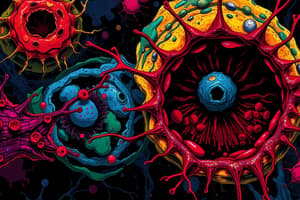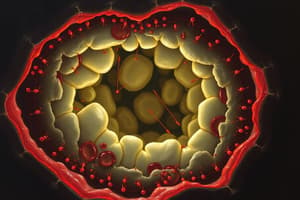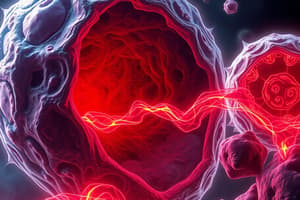Podcast
Questions and Answers
What characteristic staining is observed in necrotic cells?
What characteristic staining is observed in necrotic cells?
- Basophilic staining
- Eosinophilic staining (correct)
- Neutral staining
- Acidophilic staining
Which type of necrosis develops primarily due to ischemia?
Which type of necrosis develops primarily due to ischemia?
- Apoptotic Necrosis
- Ferroptotic Necrosis
- Liquefaction Necrosis
- Coagulation Necrosis (correct)
What is the term for the pale nucleus and loss of basophilia in necrotic cells?
What is the term for the pale nucleus and loss of basophilia in necrotic cells?
- Karyopicnosis
- Cariolysis (correct)
- Pyknosis
- Cariorexless
Which form of necrosis retains the integrity of the cell without digestion?
Which form of necrosis retains the integrity of the cell without digestion?
Which type of necrosis is notably characterized by enzymatic destruction?
Which type of necrosis is notably characterized by enzymatic destruction?
Flashcards
Necrosis
Necrosis
Cell death characterized by staining of cells with eosin, a glassy appearance, and potential calcification.
Karyopyknosis
Karyopyknosis
A form of nuclear change in necrosis where the nucleus shrinks and becomes more basophilic.
Cariolysis
Cariolysis
A form of nuclear change in necrosis marked by a pale nucleus and loss of basophilia due to DNA degradation by endonucleases.
Coagulation necrosis
Coagulation necrosis
Signup and view all the flashcards
Liquefaction necrosis
Liquefaction necrosis
Signup and view all the flashcards
Study Notes
Cell Injury: Necrosis
- Necrosis is a type of cell death characterized by the premature disintegration of cells.
- Necrotic cells stain eosinophilic and display a glassy, homogenous appearance.
- Calcification, a process where calcium deposits within the cells, can occur in necrotic cells. This is called dystrophic calcification.
Types of Cell Death
- Cell death includes necrosis, apoptosis, pyroptosis, necroptosis, and ferroptosis.
Necrosis: Detailed Characteristics
- RNA, which typically stains basophilic (darker), is lost in necrotic cells.
- Denatured (changed) proteins, generally, increase in necrotic cells.
- Glycogen is often lost in necrotic cells.
DNA Damage in Necrosis
- Karyopicnosis is a nuclear shrinkage and increased basophilia; often seen in apoptosis, also occurs in necrosis.
- A picnotic nucleus results from fragmentation of the nucleus.
- Karyolysis involves a pale nucleus due to loss of basophilia, caused by endonuclease-induced DNA loss.
Types of Necrosis
-
Coagulation Necrosis:
- Occurs after ischemia (restricted blood flow)
- The most prevalent type of necrosis.
- Ischemic conditions cause a drop in pH
- Enzymes and proteins denature (lose their structure)
- No enzymatic degradation happens.
-
Other Types of Necrosis:
- Enzymatic destruction of cells is involved.
- Liquefactive Necrosis: Cell breakdown into liquid viscous substance, often observed in brains and abscesses.
- Gangrenous Necrosis: Typically, found in extremities, it has a two-part categorization, dry and wet gangrene. Dry gangrene demonstrates coagulation necrosis while wet gangrene also includes liquefaction necrosis.
- Caseous Necrosis: Shows a cheese-like appearance and is commonly associated with tuberculosis.
- Fat Necrosis (Saponification Necrosis):
- Is characterized by the breakdown of fat tissues due to trauma and pancreatitis.
- Fibrinoid Necrosis: Immunity complex vasculitis (PAN), and other similar conditions often lead to this type of necrosis.
Additional Notes
- Coagulation necrosis maintains cellular integrity, whereas in other forms necrosis, cells are degraded.
- Eosinophilic dead cells devoid of nuclei (ghost cells) are a feature of coagulation necrosis.
Studying That Suits You
Use AI to generate personalized quizzes and flashcards to suit your learning preferences.




